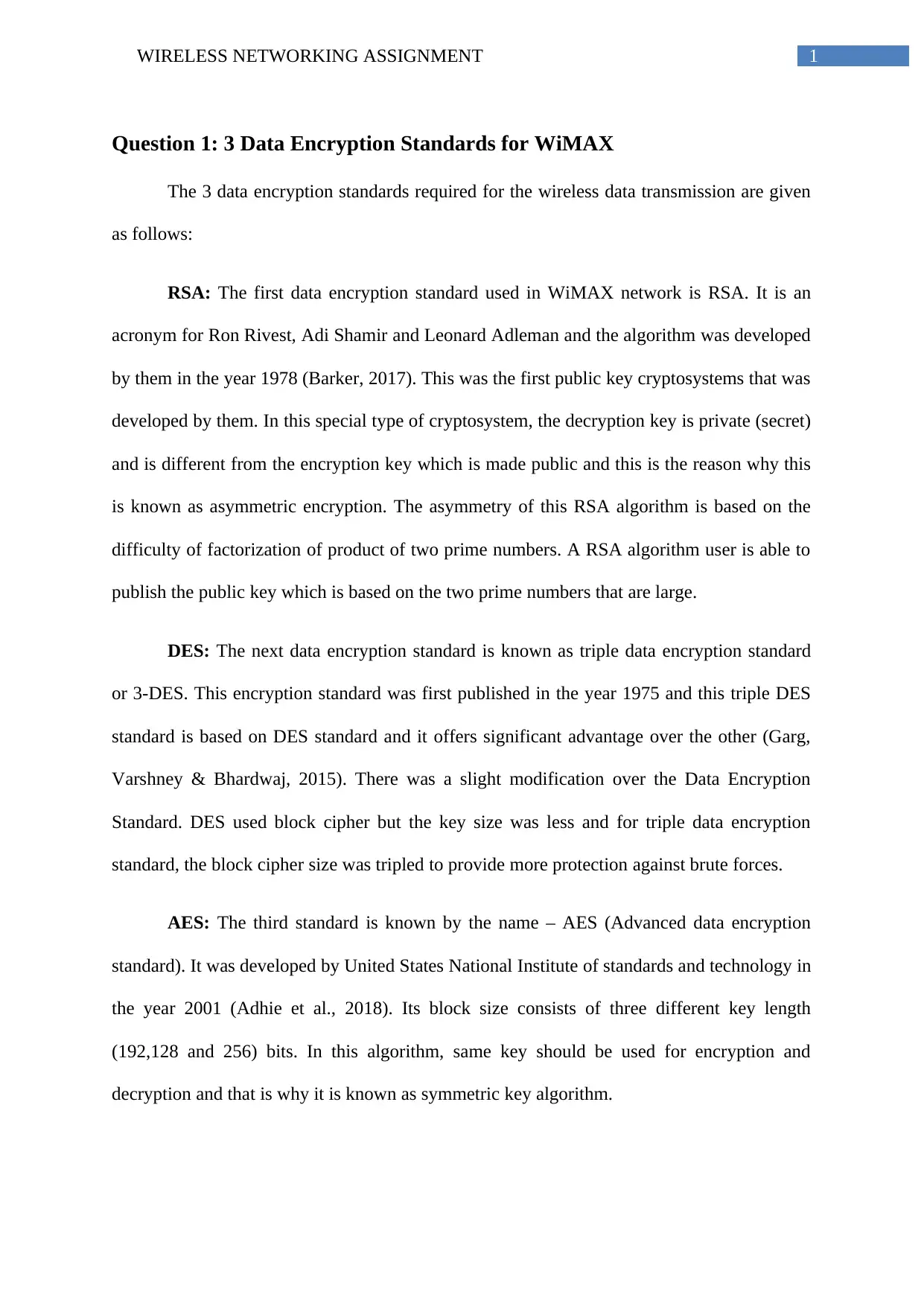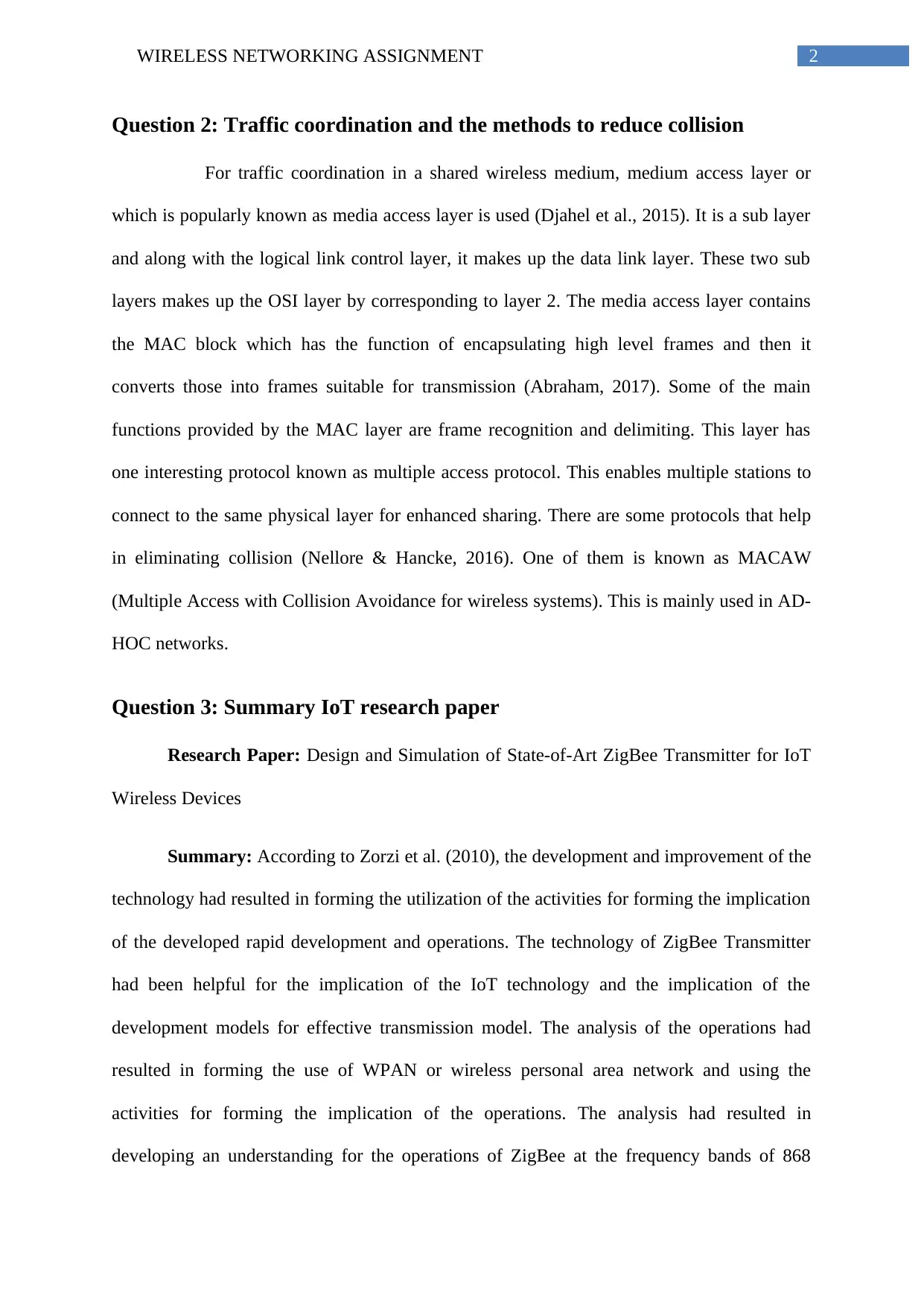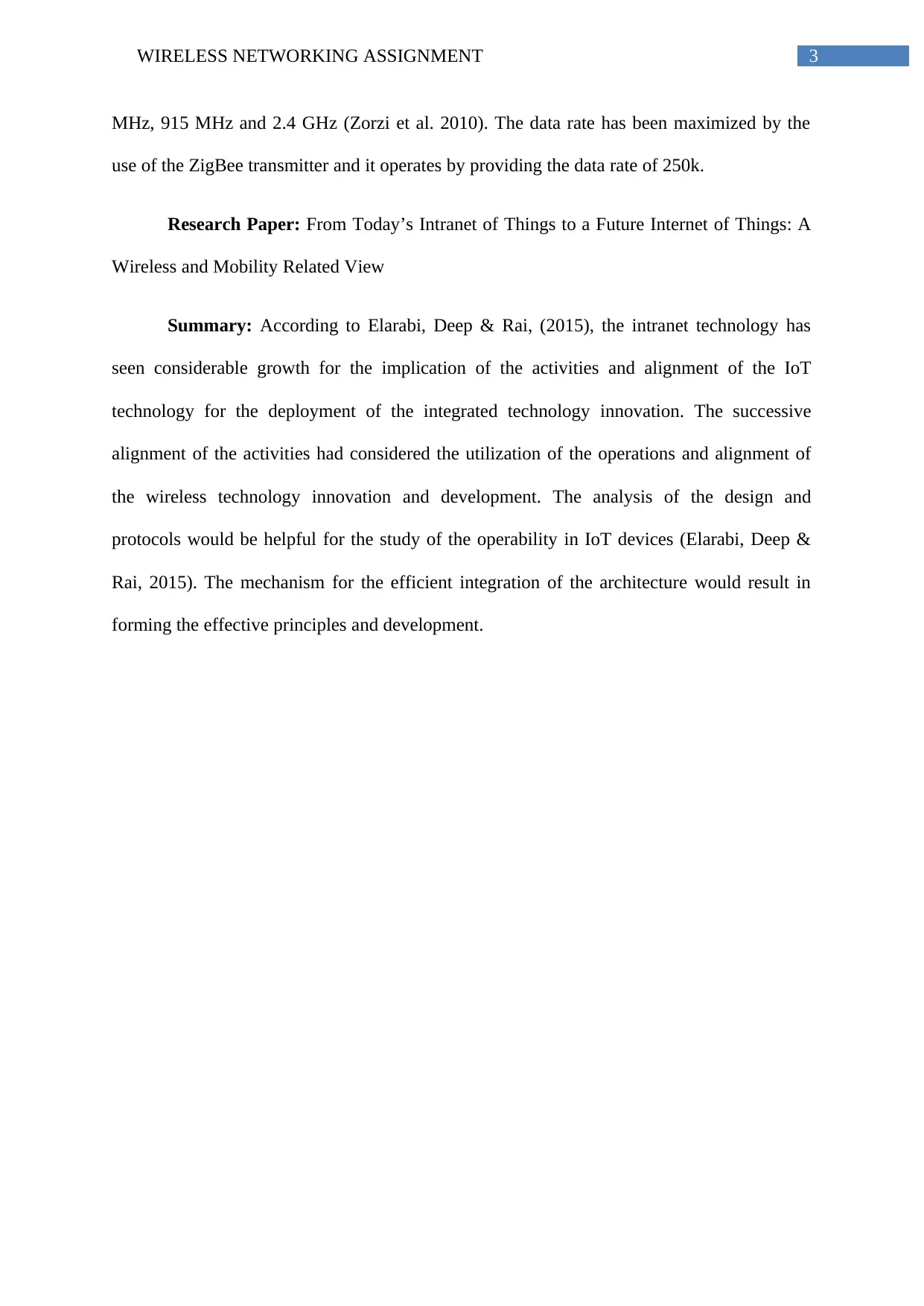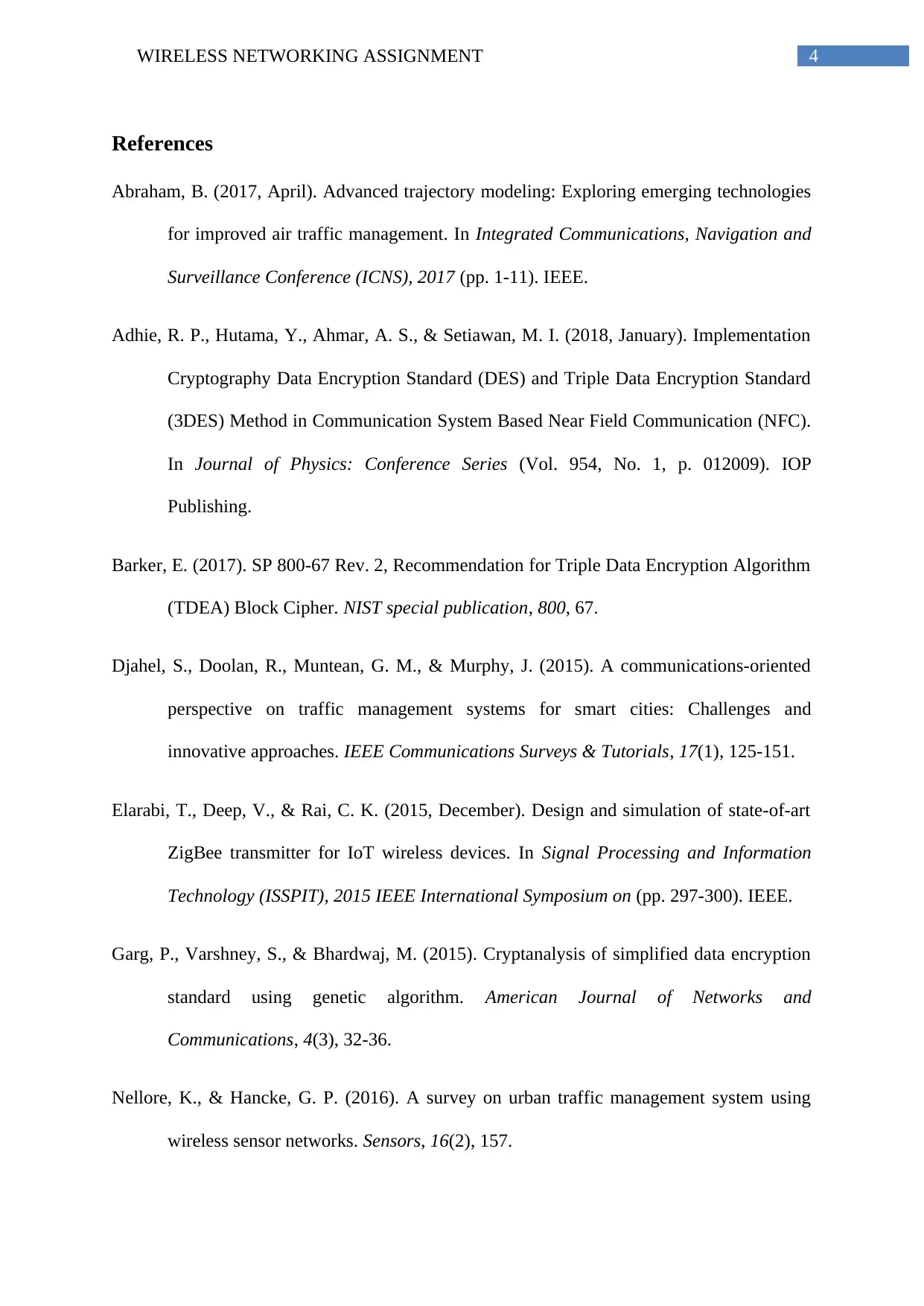Wireless Networking Assignment - Electrical Engineering
VerifiedAdded on 2021/05/31
|6
|1264
|236
Homework Assignment
AI Summary
This assignment delves into the core concepts of wireless networking, covering essential aspects such as data encryption standards, traffic coordination, and summaries of relevant research papers. The solution explores three key data encryption standards: RSA, DES (including 3-DES), and AES, detailing their functionalities and significance in securing wireless data transmission. Furthermore, the assignment examines traffic coordination within shared wireless mediums, focusing on the role of the media access layer (MAC) and protocols designed to mitigate collisions. Finally, it includes summaries of two IoT research papers, one focusing on the design and simulation of a ZigBee transmitter and the other on the transition from the 'Intranet of Things' to a future 'Internet of Things' with a wireless and mobility-related view. The assignment provides a comprehensive overview of key technologies and concepts in the field of wireless networking, providing valuable insights for students studying electrical engineering or related disciplines.

Running head: WIRELESS NETWORKING ASSIGNMENT
Wireless Networking Assignment:
Name of the Student:
Name of the University:
Author Note:
Wireless Networking Assignment:
Name of the Student:
Name of the University:
Author Note:
Paraphrase This Document
Need a fresh take? Get an instant paraphrase of this document with our AI Paraphraser

1WIRELESS NETWORKING ASSIGNMENT
Question 1: 3 Data Encryption Standards for WiMAX
The 3 data encryption standards required for the wireless data transmission are given
as follows:
RSA: The first data encryption standard used in WiMAX network is RSA. It is an
acronym for Ron Rivest, Adi Shamir and Leonard Adleman and the algorithm was developed
by them in the year 1978 (Barker, 2017). This was the first public key cryptosystems that was
developed by them. In this special type of cryptosystem, the decryption key is private (secret)
and is different from the encryption key which is made public and this is the reason why this
is known as asymmetric encryption. The asymmetry of this RSA algorithm is based on the
difficulty of factorization of product of two prime numbers. A RSA algorithm user is able to
publish the public key which is based on the two prime numbers that are large.
DES: The next data encryption standard is known as triple data encryption standard
or 3-DES. This encryption standard was first published in the year 1975 and this triple DES
standard is based on DES standard and it offers significant advantage over the other (Garg,
Varshney & Bhardwaj, 2015). There was a slight modification over the Data Encryption
Standard. DES used block cipher but the key size was less and for triple data encryption
standard, the block cipher size was tripled to provide more protection against brute forces.
AES: The third standard is known by the name – AES (Advanced data encryption
standard). It was developed by United States National Institute of standards and technology in
the year 2001 (Adhie et al., 2018). Its block size consists of three different key length
(192,128 and 256) bits. In this algorithm, same key should be used for encryption and
decryption and that is why it is known as symmetric key algorithm.
Question 1: 3 Data Encryption Standards for WiMAX
The 3 data encryption standards required for the wireless data transmission are given
as follows:
RSA: The first data encryption standard used in WiMAX network is RSA. It is an
acronym for Ron Rivest, Adi Shamir and Leonard Adleman and the algorithm was developed
by them in the year 1978 (Barker, 2017). This was the first public key cryptosystems that was
developed by them. In this special type of cryptosystem, the decryption key is private (secret)
and is different from the encryption key which is made public and this is the reason why this
is known as asymmetric encryption. The asymmetry of this RSA algorithm is based on the
difficulty of factorization of product of two prime numbers. A RSA algorithm user is able to
publish the public key which is based on the two prime numbers that are large.
DES: The next data encryption standard is known as triple data encryption standard
or 3-DES. This encryption standard was first published in the year 1975 and this triple DES
standard is based on DES standard and it offers significant advantage over the other (Garg,
Varshney & Bhardwaj, 2015). There was a slight modification over the Data Encryption
Standard. DES used block cipher but the key size was less and for triple data encryption
standard, the block cipher size was tripled to provide more protection against brute forces.
AES: The third standard is known by the name – AES (Advanced data encryption
standard). It was developed by United States National Institute of standards and technology in
the year 2001 (Adhie et al., 2018). Its block size consists of three different key length
(192,128 and 256) bits. In this algorithm, same key should be used for encryption and
decryption and that is why it is known as symmetric key algorithm.

2WIRELESS NETWORKING ASSIGNMENT
Question 2: Traffic coordination and the methods to reduce collision
For traffic coordination in a shared wireless medium, medium access layer or
which is popularly known as media access layer is used (Djahel et al., 2015). It is a sub layer
and along with the logical link control layer, it makes up the data link layer. These two sub
layers makes up the OSI layer by corresponding to layer 2. The media access layer contains
the MAC block which has the function of encapsulating high level frames and then it
converts those into frames suitable for transmission (Abraham, 2017). Some of the main
functions provided by the MAC layer are frame recognition and delimiting. This layer has
one interesting protocol known as multiple access protocol. This enables multiple stations to
connect to the same physical layer for enhanced sharing. There are some protocols that help
in eliminating collision (Nellore & Hancke, 2016). One of them is known as MACAW
(Multiple Access with Collision Avoidance for wireless systems). This is mainly used in AD-
HOC networks.
Question 3: Summary IoT research paper
Research Paper: Design and Simulation of State-of-Art ZigBee Transmitter for IoT
Wireless Devices
Summary: According to Zorzi et al. (2010), the development and improvement of the
technology had resulted in forming the utilization of the activities for forming the implication
of the developed rapid development and operations. The technology of ZigBee Transmitter
had been helpful for the implication of the IoT technology and the implication of the
development models for effective transmission model. The analysis of the operations had
resulted in forming the use of WPAN or wireless personal area network and using the
activities for forming the implication of the operations. The analysis had resulted in
developing an understanding for the operations of ZigBee at the frequency bands of 868
Question 2: Traffic coordination and the methods to reduce collision
For traffic coordination in a shared wireless medium, medium access layer or
which is popularly known as media access layer is used (Djahel et al., 2015). It is a sub layer
and along with the logical link control layer, it makes up the data link layer. These two sub
layers makes up the OSI layer by corresponding to layer 2. The media access layer contains
the MAC block which has the function of encapsulating high level frames and then it
converts those into frames suitable for transmission (Abraham, 2017). Some of the main
functions provided by the MAC layer are frame recognition and delimiting. This layer has
one interesting protocol known as multiple access protocol. This enables multiple stations to
connect to the same physical layer for enhanced sharing. There are some protocols that help
in eliminating collision (Nellore & Hancke, 2016). One of them is known as MACAW
(Multiple Access with Collision Avoidance for wireless systems). This is mainly used in AD-
HOC networks.
Question 3: Summary IoT research paper
Research Paper: Design and Simulation of State-of-Art ZigBee Transmitter for IoT
Wireless Devices
Summary: According to Zorzi et al. (2010), the development and improvement of the
technology had resulted in forming the utilization of the activities for forming the implication
of the developed rapid development and operations. The technology of ZigBee Transmitter
had been helpful for the implication of the IoT technology and the implication of the
development models for effective transmission model. The analysis of the operations had
resulted in forming the use of WPAN or wireless personal area network and using the
activities for forming the implication of the operations. The analysis had resulted in
developing an understanding for the operations of ZigBee at the frequency bands of 868
⊘ This is a preview!⊘
Do you want full access?
Subscribe today to unlock all pages.

Trusted by 1+ million students worldwide

3WIRELESS NETWORKING ASSIGNMENT
MHz, 915 MHz and 2.4 GHz (Zorzi et al. 2010). The data rate has been maximized by the
use of the ZigBee transmitter and it operates by providing the data rate of 250k.
Research Paper: From Today’s Intranet of Things to a Future Internet of Things: A
Wireless and Mobility Related View
Summary: According to Elarabi, Deep & Rai, (2015), the intranet technology has
seen considerable growth for the implication of the activities and alignment of the IoT
technology for the deployment of the integrated technology innovation. The successive
alignment of the activities had considered the utilization of the operations and alignment of
the wireless technology innovation and development. The analysis of the design and
protocols would be helpful for the study of the operability in IoT devices (Elarabi, Deep &
Rai, 2015). The mechanism for the efficient integration of the architecture would result in
forming the effective principles and development.
MHz, 915 MHz and 2.4 GHz (Zorzi et al. 2010). The data rate has been maximized by the
use of the ZigBee transmitter and it operates by providing the data rate of 250k.
Research Paper: From Today’s Intranet of Things to a Future Internet of Things: A
Wireless and Mobility Related View
Summary: According to Elarabi, Deep & Rai, (2015), the intranet technology has
seen considerable growth for the implication of the activities and alignment of the IoT
technology for the deployment of the integrated technology innovation. The successive
alignment of the activities had considered the utilization of the operations and alignment of
the wireless technology innovation and development. The analysis of the design and
protocols would be helpful for the study of the operability in IoT devices (Elarabi, Deep &
Rai, 2015). The mechanism for the efficient integration of the architecture would result in
forming the effective principles and development.
Paraphrase This Document
Need a fresh take? Get an instant paraphrase of this document with our AI Paraphraser

4WIRELESS NETWORKING ASSIGNMENT
References
Abraham, B. (2017, April). Advanced trajectory modeling: Exploring emerging technologies
for improved air traffic management. In Integrated Communications, Navigation and
Surveillance Conference (ICNS), 2017 (pp. 1-11). IEEE.
Adhie, R. P., Hutama, Y., Ahmar, A. S., & Setiawan, M. I. (2018, January). Implementation
Cryptography Data Encryption Standard (DES) and Triple Data Encryption Standard
(3DES) Method in Communication System Based Near Field Communication (NFC).
In Journal of Physics: Conference Series (Vol. 954, No. 1, p. 012009). IOP
Publishing.
Barker, E. (2017). SP 800-67 Rev. 2, Recommendation for Triple Data Encryption Algorithm
(TDEA) Block Cipher. NIST special publication, 800, 67.
Djahel, S., Doolan, R., Muntean, G. M., & Murphy, J. (2015). A communications-oriented
perspective on traffic management systems for smart cities: Challenges and
innovative approaches. IEEE Communications Surveys & Tutorials, 17(1), 125-151.
Elarabi, T., Deep, V., & Rai, C. K. (2015, December). Design and simulation of state-of-art
ZigBee transmitter for IoT wireless devices. In Signal Processing and Information
Technology (ISSPIT), 2015 IEEE International Symposium on (pp. 297-300). IEEE.
Garg, P., Varshney, S., & Bhardwaj, M. (2015). Cryptanalysis of simplified data encryption
standard using genetic algorithm. American Journal of Networks and
Communications, 4(3), 32-36.
Nellore, K., & Hancke, G. P. (2016). A survey on urban traffic management system using
wireless sensor networks. Sensors, 16(2), 157.
References
Abraham, B. (2017, April). Advanced trajectory modeling: Exploring emerging technologies
for improved air traffic management. In Integrated Communications, Navigation and
Surveillance Conference (ICNS), 2017 (pp. 1-11). IEEE.
Adhie, R. P., Hutama, Y., Ahmar, A. S., & Setiawan, M. I. (2018, January). Implementation
Cryptography Data Encryption Standard (DES) and Triple Data Encryption Standard
(3DES) Method in Communication System Based Near Field Communication (NFC).
In Journal of Physics: Conference Series (Vol. 954, No. 1, p. 012009). IOP
Publishing.
Barker, E. (2017). SP 800-67 Rev. 2, Recommendation for Triple Data Encryption Algorithm
(TDEA) Block Cipher. NIST special publication, 800, 67.
Djahel, S., Doolan, R., Muntean, G. M., & Murphy, J. (2015). A communications-oriented
perspective on traffic management systems for smart cities: Challenges and
innovative approaches. IEEE Communications Surveys & Tutorials, 17(1), 125-151.
Elarabi, T., Deep, V., & Rai, C. K. (2015, December). Design and simulation of state-of-art
ZigBee transmitter for IoT wireless devices. In Signal Processing and Information
Technology (ISSPIT), 2015 IEEE International Symposium on (pp. 297-300). IEEE.
Garg, P., Varshney, S., & Bhardwaj, M. (2015). Cryptanalysis of simplified data encryption
standard using genetic algorithm. American Journal of Networks and
Communications, 4(3), 32-36.
Nellore, K., & Hancke, G. P. (2016). A survey on urban traffic management system using
wireless sensor networks. Sensors, 16(2), 157.

5WIRELESS NETWORKING ASSIGNMENT
Zorzi, M., Gluhak, A., Lange, S., & Bassi, A. (2010). From today's intranet of things to a
future internet of things: a wireless-and mobility-related view. IEEE Wireless
Communications, 17(6).
Zorzi, M., Gluhak, A., Lange, S., & Bassi, A. (2010). From today's intranet of things to a
future internet of things: a wireless-and mobility-related view. IEEE Wireless
Communications, 17(6).
⊘ This is a preview!⊘
Do you want full access?
Subscribe today to unlock all pages.

Trusted by 1+ million students worldwide
1 out of 6
Related Documents
Your All-in-One AI-Powered Toolkit for Academic Success.
+13062052269
info@desklib.com
Available 24*7 on WhatsApp / Email
![[object Object]](/_next/static/media/star-bottom.7253800d.svg)
Unlock your academic potential
Copyright © 2020–2025 A2Z Services. All Rights Reserved. Developed and managed by ZUCOL.




